Discover the grandeur of India’s heritage havelis in Delhi, Rajasthan, and Gujarat, showcasing exquisite architecture and rich historical charm.
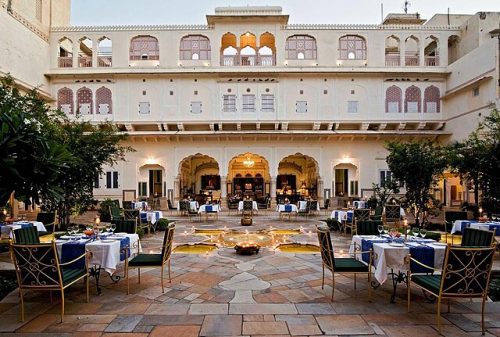
Heritage Havelis of India narrate the stories of its illustrious past. Among these are the Havelis of Delhi, Rajasthan and Gujarat, magnificent mansions that stand as a testament to the grandeur and opulence of yesteryears.
By experiencing the grandeur of havelis firsthand, whether through staying in haveli hotels or exploring the surrounding areas, visitors can gain a deeper appreciation for India’s rich cultural heritage. From the intricate carvings adorning the facades to the vibrant frescoes on the walls, havelis offer a window into the nation’s soul, a testament to the enduring spirit of its people.
Havelis in the Walled City of Delhi
The Walled City of Delhi, also known as Old Delhi, houses a rich collection of havelis that have served as cultural repositories for generations. Many of these Havelis, dating back to the Mughal era, were once the domain of the city’s elite. However, as the area became increasingly congested, many owners abandoned their ancestral homes.
In recent years, there has been renewed interest in preserving these heritage structures. Several individuals have stepped up to restore dilapidated havelis, converting them into vibrant cultural spaces.
Kathika Haveli
One notable example is the Kathika Cultural Centre, created by combining two crumbling havelis in Sitaram Bazar. Kathika, meaning “a collection of stories,” has become a popular cultural spot in Old Delhi, hosting events such as book readings, poetry recitations, workshops, dance performances, discussions, ghazal evenings, and film screenings.
The haveli also showcases the history of Delhi through old paintings, historic crafts, photographs, and a collection of everyday objects. Visitors can marvel at vintage mirrors, telephones, clocks, walking sticks, almirahs, safes, old-fashioned iron presses, typewriters, and radios, among other intriguing items.
Haveli Dharampura
In the winding lanes of Chawri Bazaar and Kuncha Seth in Old Delhi stands the UNESCO-awarded Haveli Dharampura. Built in 1887, this exquisite haveli has been meticulously restored over six years by dedicated historians and skilled architects who ensured its design remained as true to the original as possible. The haveli is adorned with intricate woodwork on the rooftops, sculptures, and engravings of Hindu goddesses in stone and steel, antique balconies, and jharokhas that open to the bustling streets of Chandni Chowk.
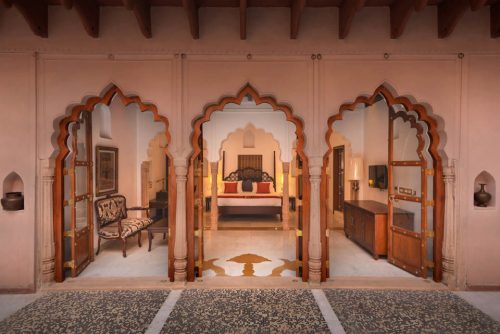
Staying true to the aesthetics of its era, the haveli boasts marble courtyards on every floor, lattice windows or jharokhas, woodwork inspired by original designs, and narrow staircases. The original safe, or tijori, used by its first owners to store money and valuables, is also on display.
Haveli Dharampura offers 14 rooms, seven on each floor. Half of these rooms are named after the seven gates that once guarded the old city of Shahjahanabad, while the other half draws inspiration from the iconic markets of Chandni Chowk, such as Dariba Kalan and Kinari Bazaars.
Heritage Havelis in Rajasthan to experience history
Patwon Ki Haveli, Jaisalmer
Built in the early 19th century by wealthy merchant Guman Chand Patwa, Patwon Ki Haveli is a cluster of five intricately designed houses. This haveli has been meticulously restored to preserve its detailed carvings and elaborate murals and is now owned by the Archaeological Survey of India.. Offering a unique glimpse into Rajasthani culture, its rooms feature intricate woodwork and mirror decorations.
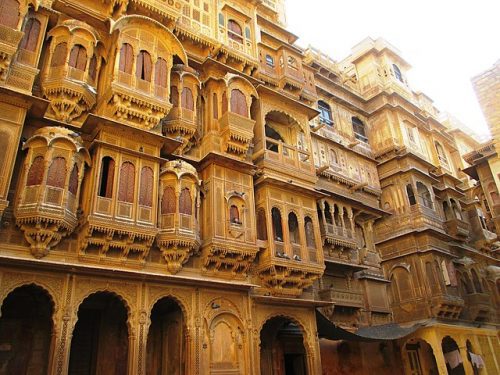
Today, Patwon Ki Haveli functions as a house museum, showcasing the finest craftsmanship of Rajasthani haveli architecture. Visitors can explore restored rooms, including the house temple, living quarters, dining room, dressing room, and main drawing room, many of which open onto an inner courtyard.
The yellow sandstone mansion, with its intricate lattice or jali carvings, boasts about 60 balconies and arches, each uniquely styled. The walls are adorned with exquisite mirrorwork and beautiful paintings, and the museum inside offers antique furniture and artefacts. This architectural marvel, with its rich history and stunning design, is a must-visit for anyone in Jaisalmer.
While it functions more as a museum than a hotel, nearby accommodations often offer traditional Rajasthani cuisine, such as dal baati churma and gatte ki sabzi.
Nathmal Ki Haveli, Jaisalmer
Nathmal Ji Ki Haveli, a beautiful and historic mansion, is located in the heart of Jaisalmer City in Rajasthan. Known for its stunning symmetrical architecture and exquisite carvings, it stands as one of the most popular tourist attractions in Jaisalmer. Built in the late 19th century by two brothers, Nathmal and Hathi Singh, this haveli was commissioned by the Maharawal of Jaisalmer, who was deeply impressed by their craftsmanship. The construction took nearly 22 years to complete.
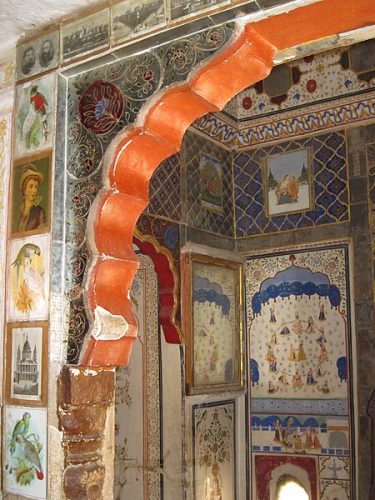
The architecture of Nathmal Ji Ki Haveli is a unique blend of Rajput and Islamic influences, exemplifying the Bhunga style. Its intricate carvings cover the façade, and its bright yellow paint makes it stand out in the cityscape of Jaisalmer. The haveli’s design is a testament to the region’s rich history and culture, making it a must-see for anyone visiting the area.
Although primarily a historic site, visitors can stay in nearby heritage hotels that feature rooms inspired by the haveli’s opulent design, offering traditional dishes like laal maas and ker sangri.
Samode Haveli, Jaipur
Samode Haveli stands as a testament to regal Rajasthani grandeur, a 225-year-old architectural marvel offering a serene escape from the bustling streets of the old town. Dating back over 175 years, Samode Haveli was originally built as a residence for the royal family. This haveli has been carefully restored to maintain its regal charm, featuring frescoes and mirror work. The rooms and suites are adorned with traditional Rajasthani decor textures—from intricately hand-painted murals adorning the walls to ornate doorways and lush courtyards.
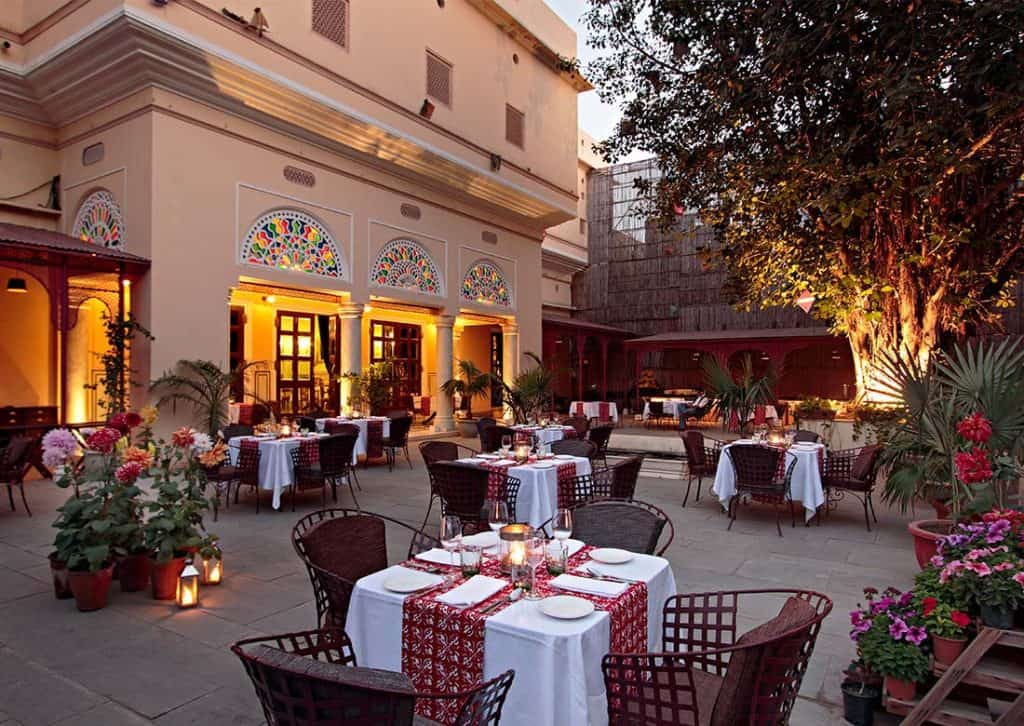
Each corridor leads to discoveries, and every courtyard serves as a tranquil oasis. Terraces provide panoramic views of the city, while hidden alcoves invite moments of quiet contemplation. The poolside bar offers a peaceful daytime retreat, and the lobby bar, surrounded by fruit trees and fountains, exudes evening charm. For an intimate dining experience, private dining by the poolside or at the private stepwell is available.
The grand signature restaurant at Samode Haveli presents both Indian and international cuisines, focusing on traditional Rajasthani flavours.
Mandawa Haveli, Mandawa
Mandawa Haveli, originally constructed in the 18th century by prosperous merchants, exudes timeless charm. In 1978, Thakur Devi Singhji Mandawa and his wife Sajjan Kunwar graciously opened the castle’s doors to guests, transforming the historical castle into a heritage hotel. Today, this architectural gem captivates visitors with its intricate design, inviting them to step back in time and experience the regal grandeur and warm hospitality that defines Mandawa Haveli.
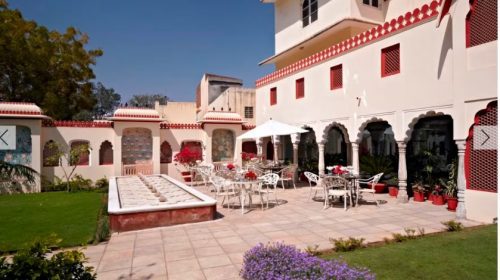
Mandawa Haveli is famous for its stunning frescoes depicting various themes. The restoration has preserved its historical charm while adding modern amenities. The haveli’s rooms are decorated with period furniture and traditional art, and the on-site restaurant serves authentic Rajasthani cuisine, including specialities like bajra roti and daal bati.
Alsisar Haveli, Jaipur
Constructed in 1892, Alsisar Haveli showcases traditional Rajasthani architecture and has been restored to maintain its historical grandeur. Owned by a branch of the “Kachawa” clan of Rajputs, Alsisar Haveli features large, spacious rooms with tall ceilings and period decor. Alsisar Haveli offers 45 tastefully crafted heritage-style rooms, each equipped with state-of-the-art amenities. The rooms, reminiscent of those used by the nobles of Alsisar, feature antique furniture, intricately carved poster beds, and delicate medieval motifs on fabrics, providing guests with an authentic royal Rajasthani experience.
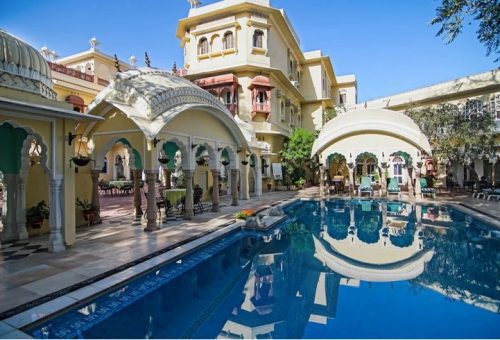
Guests can relax in artistically decorated rooms, stroll through the sublime courtyards, and linger on the quaint balconies. The dining room is a highlight, with its impressive decor, height, and elegance, perfectly capturing the late Victorian opulence of the era when the house was built. Guests can enjoy traditional Rajasthani dishes in the hotel’s restaurant, such as pyaaz kachori and ghewar.
Bagore Ki Haveli, Udaipur
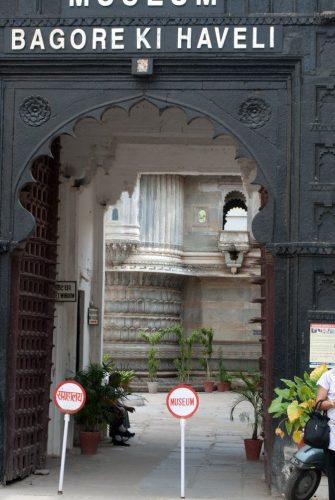
Built in the 18th century by Amar Chand Badwa, the Prime Minister of Mewar, Bagore Ki Haveli is now a museum showcasing traditional Rajasthani art and culture. Restoration has focused on preserving its historical significance and artistic beauty.
The Haveli has 138 rooms, along with numerous corridors, balconies, courtyards, and terraces including the Chambers of the Royal Ladies which feature fine frescoes in the Mewari style, and vibrant stained-glass windows. The quarters of the royal ladies, bathrooms, dressing rooms, bedrooms, living rooms, and worship rooms are adorned with intricate and exquisite mirror work. Visitors can also admire unique symbols of the Rajput clan, such as jewellery boxes, dice games, hukkas, pan boxes, nutcrackers, hand fans, rose water sprinklers, copper vessels, and other items on display.
In the evening, the haveli comes alive with the popular Dharohar Dance Show that is held here every evening which showcases the culture and folk tradition of Rajasthan. While the haveli itself doesn’t offer accommodations, nearby heritage hotels inspired by its architecture provide luxurious rooms and traditional Rajasthani cuisine.
Rohet Garh, Rohet, Jodhpur
Dating back to 1622, Rohet Garh has been meticulously restored to maintain its historical charm and elegance. The restoration has preserved its beautiful courtyards, elegant lounge, serene verandas, terraces and traditional decor. With thirty-two beautifully appointed rooms, including six suites, are designed in-house in traditional hues. with period furnishings and traditional textiles. Each space is distinguished by its frescoes and high-quality furniture,
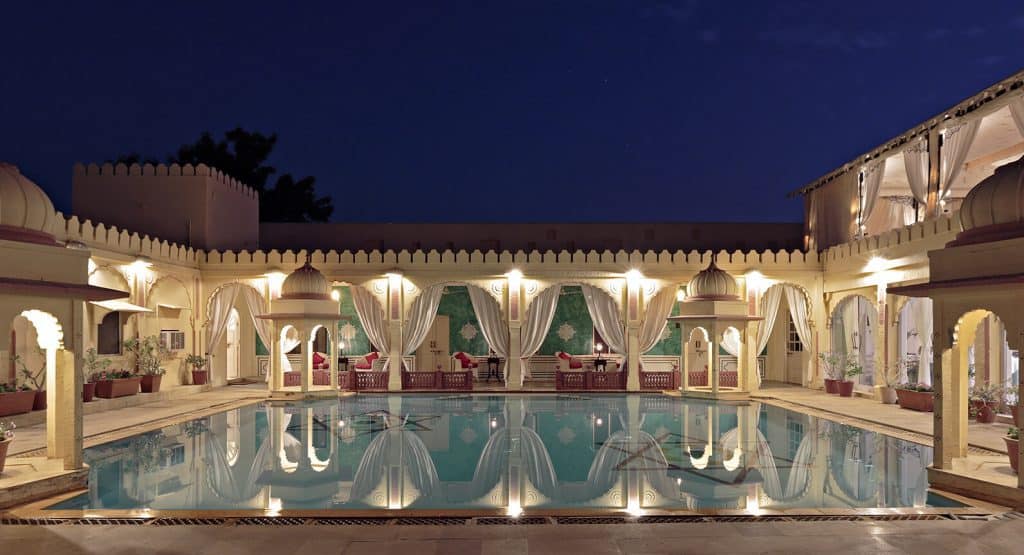
Situated on the banks of a serene lake and nestled amidst sprawling lawns and manicured gardens, the property is frequented by a multitude of birds and dancing peacocks, A swimming pool, flanked by four charming pavilions, beckons for a refreshing dip. Often, dinner is served poolside, with folk musicians enhancing the evening atmosphere.
Rohet Garh prides itself on its exceptional traditional cuisine, with one of the finest kitchens in the region. The chefs have been trained by the late Thakurani Sahiba, the lady of the house and author of “Cuisine of Rohet Garh,” ensuring that each dish is a testament to culinary excellence.
Narendra Bhawan, Bikaner
Originally a royal residence, Narendra Bhawan has been transformed into a luxurious heritage property. Narendra Bhawan Bikaner captures the story of the last reigning Maharaja of Bikaner, His Highness Narendra Singhji. Born during a transformative era in India, the young prince’s residence reflects his modern tastes and outlook. The restoration has combined its historical elements with contemporary design, creating a unique blend of old and new. The property offers rooms with a mix of traditional and modern decor.
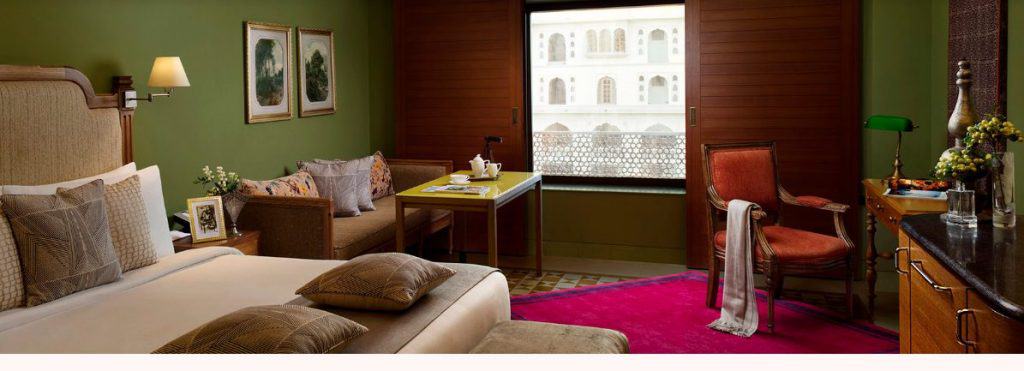
The Bhawan celebrates the Maharaja’s life through a curated collection of artefacts and objects. It showcases influences from Bombay’s art deco movement to the glamour of Broadway, blending rich velveteen fabrics, chiffons, and pearls to create an eclectic and stylish palace residence.
Narendra Singhji’s passion for hunting led him to Darbari Lake, now an enchanting setting with white canopies adorned with soft lights. Guests can enjoy private, intimate evenings here, with low mattress seating, gentle flute music, and gourmet delicacies served under the starlit sky. Guests can enjoy a fine dining experience with a variety of cuisines, including traditional Rajasthani dishes, at its restaurant.
Heritage Havelis in Gujarat to experience a stay
Gujarat is dotted with numerous havelis built by affluent merchants, showcasing intricate architecture that is a feast for the eyes. Some notable examples include Tambekar Wada in Vadodara, Bohra Haveli in Siddhpur, Darbar Gopaldas Haveli in Kheda district, and Swaminarayan Haveli Temple in Ahmedabad. Vaso in Kheda district is renowned for its havelis, which are internationally acclaimed for their elaborate designs and craftsmanship.
The Havelis of Gujarat are characterized by the extensive use of wood, particularly in columns, brackets, frontages, and courtyards. In the past, wood in architecture was a symbol of prestige, but the extent of the carving within a home depended on the owner’s wealth. The woodwork in these havelis is often coated with black preservative oil, giving it a distinctive dark appearance. While the basic architecture of all havelis remains consistent, some have unique additions that set them apart.
Sidhpur Havelis, Sidhpur
These havelis, built by the affluent Bohra Muslim community in the 19th and early 20th centuries, are renowned for their intricate woodwork and stucco decorations. Restoration has focused on preserving their architectural beauty and cultural significance. The havelis themselves are more historical sites than hotels, but nearby heritage accommodations offer rooms inspired by their design. Traditional Bohra and Gujarati cuisine can be enjoyed in local eateries.
The history is interesting. The pastel-hued mansions of Sidhpur, with their ink blue, lime, and mint facades, remain impeccably preserved, lining the quiet streets in a display of architectural splendour. The havelis reflect a blend of Victorian, European, Islamic, and Indian architectural styles. Primarily wooden, these narrow but deep houses are centred around small courtyards designed to provide ventilation in the hot, dry climate.
Delicate details still adorn the doorways, staircases, floors, and ceilings. Geometric tiles and intricate friezes grace the walls, where once ornate tables were set beneath glittering chandeliers for parties and dinners. A testament to the community’s wealth, some Bohra families continue to visit and maintain these ancestral homes, preserving their historical and cultural legacy.
Heritage House, Ahmedabad
Built in the early 20th century, Heritage House showcases traditional Gujarati architecture. Restoration efforts have preserved its original woodwork and intricate carvings. This Heritage Haveli, once the residence of a prominent textile merchant, holds historical significance as Mahatma Gandhi stayed here after returning from South Africa in 1915.
The Haveli features 38 beautifully appointed rooms, combining modern amenities with a grand yet homely ambience. Adding to the unique experience, there is a gallery showcasing traditional Indian textiles, a boutique of tribal heirlooms, and a heritage bookstore, making every visit truly special.
The hotel offers rooms with a blend of traditional decor and modern comforts. Guests can enjoy authentic Gujarati cuisine, including specialities like undhiyu and fafda, in its restaurant.
Jethabhai Ni Haveli, Ahmedabad
Constructed in the 19th century, Jethabhai Ni Haveli is famous for its stunning wood carvings and historical significance. Restoration has focused on maintaining its artistic and architectural integrity. 250 year old haveli in the heart of ahmedabad Jetha bhai ni Haveli Haveli also has a toy museum. While the Haveli itself doesn’t offer accommodations, nearby heritage hotels provide rooms inspired by its design. Traditional Gujarati dishes can be enjoyed in local restaurants.
Mangaldas Ni Haveli, Ahmedabad
Mangaldas ni Haveli, nestled in the heart of the historic walled city of Ahmedabad, is a stunning 250-year-old wooden villa, built in the traditional style with a central courtyard. Painstakingly restored, it offers a glimpse into the rich heritage of the area. Just a 12-15 minute rickshaw ride from The House of MG, the journey to the haveli takes you through narrow bylanes and bustling bazaars, providing an immersive experience of the old city.
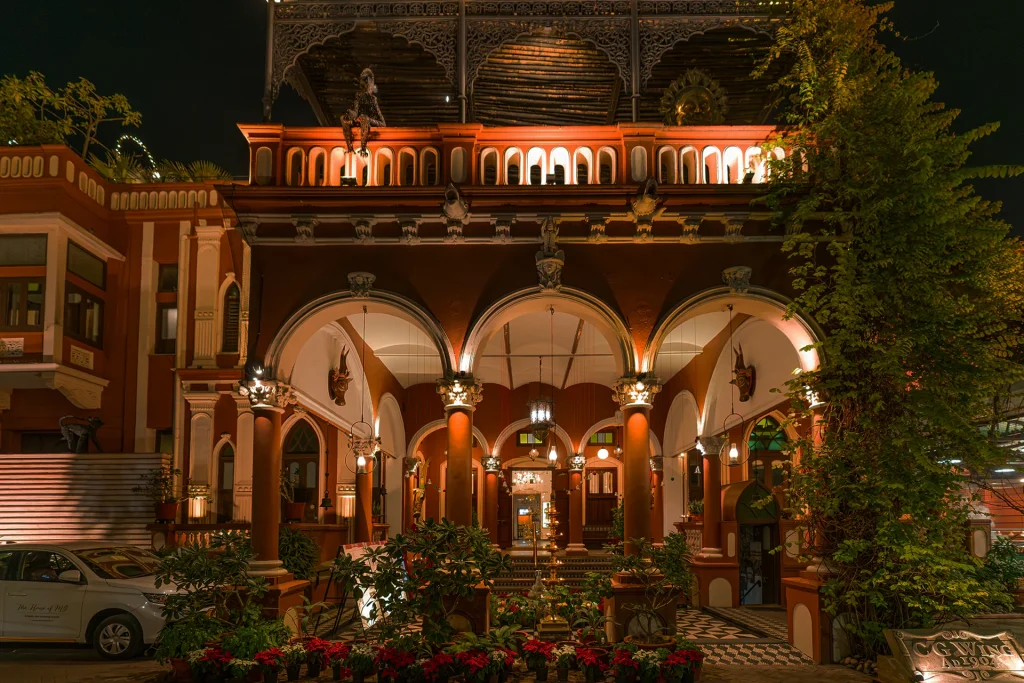
The Haveli features only two suites, creating an intimate and safe oasis amidst 600 years of living heritage. The WHC Heritage Terrace Suite, accessed by a narrow staircase, spans 900 square feet and extends to a terrace above. Guests can enjoy city views, watch the sunset, and relax under the stars. The spacious 950 square foot suite includes a charming lounge with a swing and seating area overlooking the narrow road. Internal windows offer views of the ornately carved courtyard, adding to the suite’s charm and historical ambience.
Restoration efforts have preserved its traditional decor and architectural features. The hotel offers rooms adorned with antique furniture and traditional textiles.
Darbargadh Poshina, Poshina
Darbargadh Poshina, dating back to the 12th century, was once the pride of the Chalukya dynasty, whose rulers governed Gujarat and Central India. This magnificent palace features grand gateways, a massive dome, numerous pillars and arches, courtyards, gardens, and terraces. Overlooking the scenic Aravalli mountains, its ancient fort walls are steeped in history.
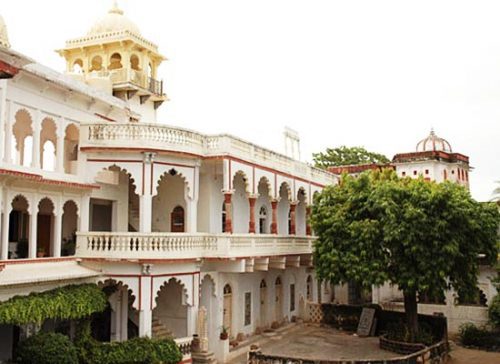
Darbargadh Poshina has been restored to preserve its historical charm and elegance. Restoration efforts have focused on maintaining its architectural integrity and traditional decor. The hotel features luxurious rooms with period furnishings and vibrant textiles.
Set in the tribal lands of the Aravallis, this heritage home invites guests to explore the rich Adivasi and Garasia tribal culture of North Gujarat and South Rajasthan. Visitors can enjoy fresh home-cooked meals, made from recipes passed down through generations, and experience the warm hospitality of a family that ruled Poshina for eight generations before independence.
The French Haveli Ahmedabad
The French Haveli, a beautifully restored 150-year-old Gujarati heritage home, offers a vibrant and cosy retreat. This artistically revived haveli retains its traditional charm while providing a unique experience of living in the historic ‘Pol’ community. Staying here means immersing oneself in Gujarati culture with all the comforts and luxuries of modern life. The open central courtyard, a hallmark of Havelis, allows for ample air and light, creating a serene environment. A traditional swing, or Jhula, invites relaxation and enhances the home’s welcoming atmosphere.
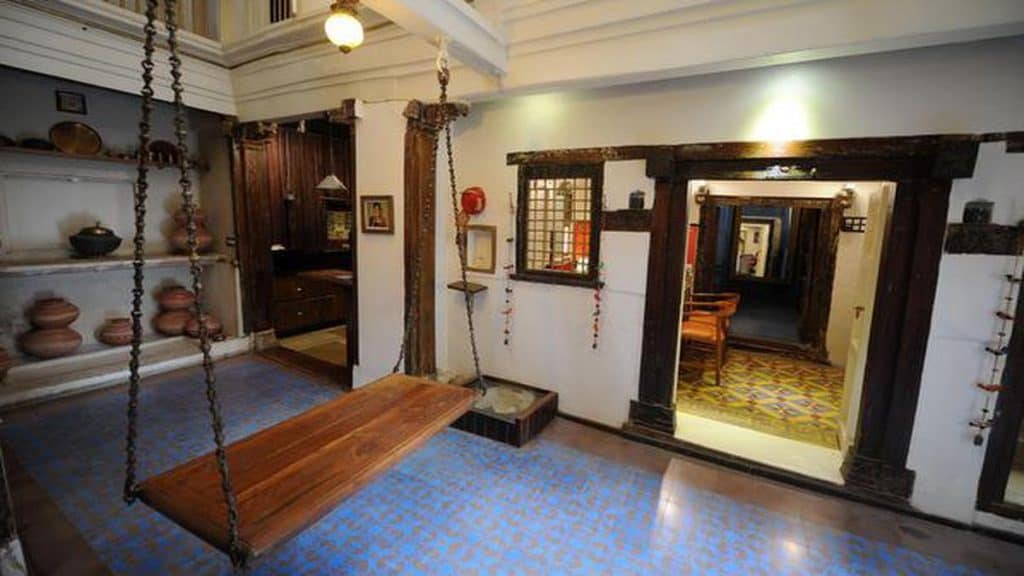
Guests at The French Haveli enjoy both privacy and a connection to the communal spaces of the Pol. Overlooking a shared area that features a Chabutra (bird feeder) and a century-old Jain temple, the haveli fosters a sense of community. Each room in the French Haveli possesses its unique charm. The rooms in the French Haveli sport quaint names like Chabutaro – The Bird Feeder and Agaasgi – The terrace.
The name French Haveli commemorates the pioneering ‘Indo-French project’ aimed at revitalizing Ahmedabad’s Old City. French architects restored and resided in this haveli, marking a significant cultural collaboration.
Baghban Haveli
Baghban Haveli, located in Dhal ni Pol, Ahmedabad, is a prominent example of Indo-French architectural heritage. This 150-year-old structure, situated on Khijada Sheri, stands out with its distinctive French façade and elements. The façade of the haveli features Victorian and Gothic architectural elements, influenced by the colonial period in India. Originally built in the 18th century, Baghban Haveli underwent a meticulous restoration process in 2017, which took about a year to complete.
This heritage-listed wooden marvel features four floors of intricate woodcarving, cement stucco, and brickwork. The architectural splendour of Baghban Haveli is evident through its detailed carvings, structural elements, and cultural and religious iconography. The haveli’s main feature is its interior courtyard, or “chowk,” which organizes the surrounding rooms and allows for natural light and ventilation. The design pays homage to traditional architecture, incorporating open-to-sky courts, wooden furnishings, distressed cerulean doors, and a traditional Gujarati swing (jhula).
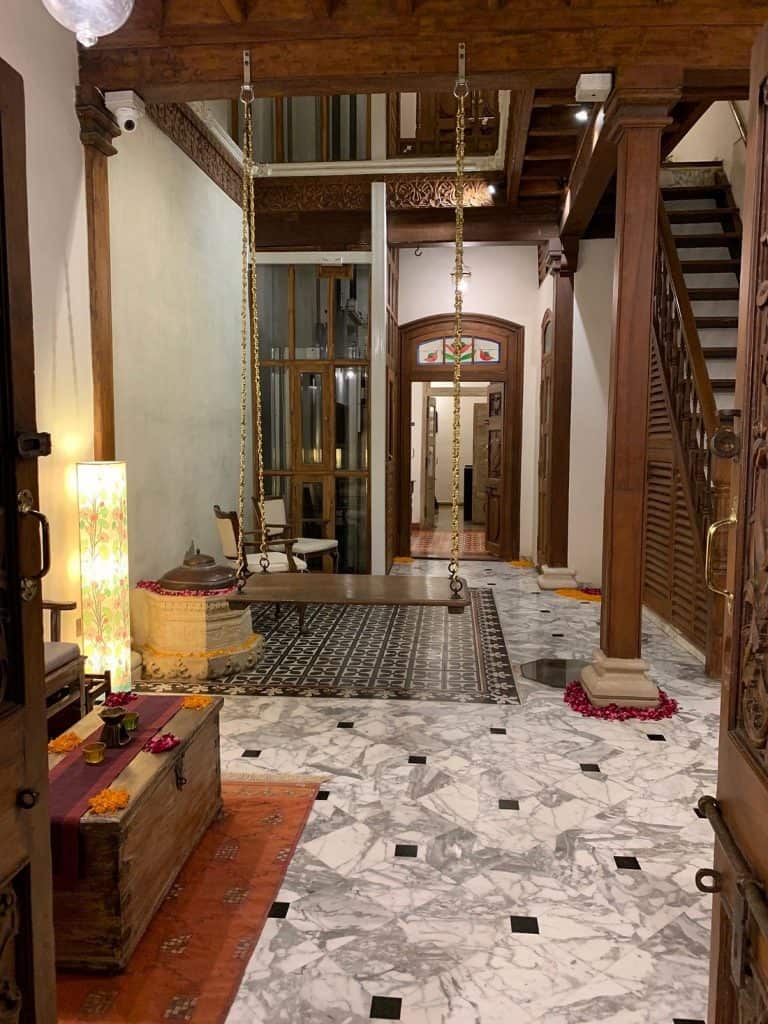
Baghban Haveli blends rustic charm with modern amenities, creating a unique boutique hotel experience that reflects Gujarati culture. The haveli offers five beautifully designed bed-and-breakfast rooms and a dining area, allowing visitors to immerse themselves in the historic ambience of Ahmedabad. Living in Baghban Haveli provides a unique experience of Gujarati culture, with the central courtyard serving as the soul of the haveli, bringing optimum air and light. The traditional swing (jhula) offers a relaxing spot to enjoy the calming effects of this heritage home.
Darbar Gopaldas Haveli
Located 16 km from Nadiad, the village of Vaso is home to the impressive Darbar Gopaldas and Mahendrishibhai’s Haveli. This 250-year-old mansion, owned by former MLA Mahendranbhai Desai, is a remarkable example of intricate woodwork. Every corner of the haveli features detailed carvings, including wooden ceilings in each room. Despite being over two centuries old, the wooden pillars and carvings remain well-preserved. The fresco paintings, created with natural colours, add to the mansion’s historical value.
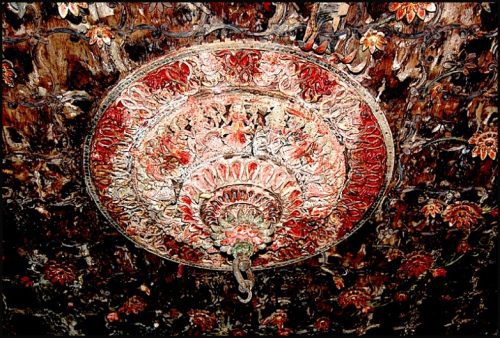
Gopaldas’s haveli, inherited from his princely ancestors, is a tourist attraction due to its architectural beauty and intricate woodwork. Film producers often rent this haveli for period movies, as it evokes the family’s royal past. The village of Vaso, with its calm atmosphere, wood-carved pillars, wall paintings, and ornate havelis, provides a peaceful retreat where one can enjoy tranquillity and silence.
A heritage walk through Vaso offers a profound sense of pride in India’s rich history, heritage, and culture. This walk is essential for enthusiasts of architecture, photography, and history, and for anyone who appreciates India’s preserved traditions and culture.
Tambekar Wada Vadodra
Tambekar Wada, located in the Raopura area of Vadodara (Baroda) at Tambekar no Khancho, is a historic Maratha mansion. This three-storey building was once the residence of Bhau Tambekar, the Diwan (Minister) of Baroda State, responsible for the administration of the state. The mansion is notable for its intricate and decaying 19th-century murals.
The structure of Tambekar Wada is an oblong four-storey building with spacious interiors. The walls, doors, and ceilings on the first and second floors are adorned with murals dating back to the 17th and 18th centuries, depicting epic scenes and everyday life in a polychrome Maratha style. These murals, some of the finest examples of Gujarat’s mural paintings, have been restored by the Archaeological Survey of India (ASI) due to damage over the years. ASI continues to conduct chemical treatments to preserve these artworks.
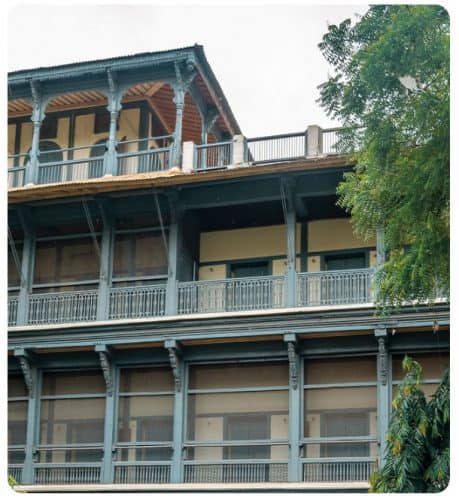
The murals include depictions of Lord Krishna’s childhood, such as breaking a pot and performing Raas with Gopis, as well as scenes of Lord Ganesha as a child and British-Maratha battles. According to the ASI, these paintings were created around 1874. The mansion houses approximately 300 paintings spread across the first to third floors, with artwork extending to door frames and featuring intricate jali designs and wood carvings.
Tambekar Wada, despite its age and wear, offers a glimpse into Maratha architecture with its delicate woodwork and tempera paintings on dry lime using water-based pigments. Originally a residence for Bhau Tambekar, the building later served as a school before being vacated. This historic mansion remains a significant cultural landmark, reflecting the rich heritage of Vadodara.
These heritage havelis offer a unique opportunity to experience the grandeur and opulence of India’s historical mansions while enjoying modern comforts and authentic regional cuisine.
By preserving and celebrating the artistry, architecture, and cultural significance of these Havelis, India continues to honour its illustrious past while providing unforgettable experiences for today’s travellers.
Read More: Latest



